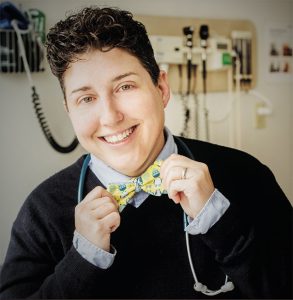Everyone who comes out as gay, lesbian, bisexual, transgender and queer (LGBTQ+) has their own unique story and experience. But, often the process begins with the person becoming comfortable with their own identity and then sharing it with friends and peers before potentially telling their family. However, the coming out process seems to have flipped for some LGBTQ+ kids during the COVID-19 pandemic—they’re now sharing with accepting family and waiting to tell peers.
“Anecdotally, we are seeing kids who’ve come out to themselves and then their family during the pandemic because they are home—away from teasing and taunting by peers,” said Dr. Angela Kade Geopferd, Medical Director of the Gender Health program at Children’s Minnesota. “However, it’s important to remember this is only among LGTBQ youth who feel supported by their parents, which is still not the case for a majority of these kids and teens.”
Safety guidelines to slow the spread of COVID-19 coupled with distance learning and the absence of extra-curricular activities are factors that keep kids at home. For kids who have a validating home environment and supportive relationships with family members, this may be an opportunity to explore their identity, experiment with gender expression at home, and share name and pronouns.

Consequences of the pandemic on LGBTQ youth
While some LGBTQ+ youth may be finding their identity, the COVID-19 pandemic has created stress in situations where their home and relational contexts are not supportive. Research suggests one-third of LGBTQ youth experience parental rejection and another one-third don’t come out until they’re adults. Another study found LGBTQ youth who feel high levels of family rejection are eight times more likely to report attempting suicide and six times more likely to report depression. In these situations, youth are encouraged to connect to safe online spaces and communities that are gender affirming, many of which have expanded during the COVID-19 pandemic. The Trevor Project offers support resources for LGTQ young people on its website.
Going back to the classroom
As schools return to in-person learning, kids who’ve come out during this time of isolation are facing a new challenge. These kids now have to navigate if they want to share their identity with friends and classmates.
“Going back to school could cause anxiety as they have to decide how to present and what name to go by. All on top of anxiety of going to school in the pandemic,” said Dr. Goepferd.
Parents and allies can support newly-out LGBTQ+ students as they return to the classroom in a number of ways, including:
- Let your child lead the way—when kids come out it’s their decision to disclose their identity.
- If kids want to use a preferred name and/or pronoun, tell the school ahead of time.
- Find a trusted person at school. Help kids connect with someone at school who affirms their identity: counselor, social worker or school nurse.
- Model and advocate for inclusive speech.
- Celebrate kids who are making brave efforts to be their authentic selves.
- Ask what the school is doing to create a gender inclusive environment.
- Advocate for inclusive curriculum.
Children’s Minnesota Gender Health program
Children’s Minnesota is a resource for your family during times of transition. The Gender Health program is an exclusively pediatric, multidisciplinary gender health program, and includes pediatric gender health, endocrinology and gynecology physicians and social work.
The Gender Health program provides compassionate and comprehensive care for transgender and gender-diverse youth. We’re dedicated to serving as an essential medical partner and resource for transgender youth and families along their journey. We are here to help, every step along the way.